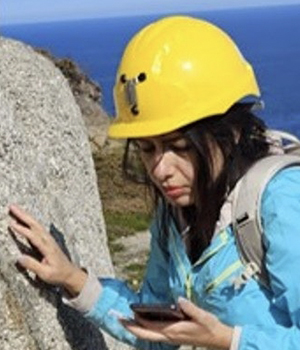Back to program
Rare Metals in Quebec: Potential and Current Knowledge
Wednesday, November 20, 2024
Room 303AB - SOQUEM
Rare metals, such as REE, Sc, Nb and Ta, play a major role in our transition to a low-carbon economy. This session aims to present the critical metal potential of the Quebec province as well as to highlight the new scientific discoveries in relation to these mineralizations (e.g., genetic models, exploration methods).
This session will be offered in French and in English.
9:00 a.m.
Rares Metals (REE, Nb, Ta) as Mantle-Crust Transfer Witness
Conference details
The REE, Nb and Ta geochemical anomalies highlight crust-mantle interactions as well as crustal differentiation. Associated with different types of magmatic rocks, including carbonatites, peralkaline silicate rocks and peraluminous granites or pegmatites, their formation takes place in a variety of geodynamic contexts (rifting, continental collision, post-orogenic extension) representative of the geological history of the lithosphere. Their genesis can be linked to various processes, including preconcentration of metals in their mantellic or crustal source, magmatic differentiation, liquid-liquid immiscibility and hydrothermalism. This presentation will discuss the state of scientific knowledge on the formation of these deposits and the (many) scientific barriers to our understanding of these objects, including (i) the metal source(s) and the fertilization mechanisms; and (ii) the geological and geochemical processes that control the transfers of these metal elements between the different lithospheric compartments.
9:40 a.m.
Rare Earth Pegmatites in Central Grenville Province: Source, Age and Formation Process
Conference details
Undeformed to slightly deformed post-tectonic granitic pegmatite dykes are common in high-grade metamorphic (amphibolite to granulite) orogenic belts. Some of these dykes are notably enriched in light rare earths (REE), Nb, Ta, Th and U. Furthermore, these mineralized pegmatite dykes generally show no temporal and/or spatial relationship with the granitic intrusions. This lack of genetic link calls into question the source of the mineralizing magmas and the processes by which these granitic magmas are enriched in critical metals. The Grenville Geological Province is a perfect laboratory to better understand the genesis of these REE-rich pegmatites due to the large number of mineralized dykes within the medium pressure Allochthon Belt (Mid-P Belt). Our work focuses on light REE-enriched pegmatites in the Haute-Mauricie and northern Lac-Saint-Jean regions. These REE-rich pegmatites form isolated metric dykes or vein systems that can be kilometric in size. They cut across all the lithologies in the area (granitic gneiss, paragneiss and gabbronorite) without the latter having any impact on the chemical composition of pegmatites. Moreover, they show no spatial relationship with the syngrenvillian to tardigrenvillian alkaline intrusions in the region. These pegmatites are formed at temperatures > 700°C following the cooling and rising of silicate liquids resulting from the partial melting of metasedimentary and meta-igneous rocks forming the root of the Mid-P belt. U-Pb dating and Hf isotopic composition of zircons derived from these pegmatites show (i) that they formed during two distinct periods (~1060 Ma to ~1045 Ma and ~1010 Ma to ~990 Ma); and (ii) that their ƐHf(t) signatures vary between ~ +2 and -13. These data therefore indicate that the silicate liquids from which these pegmatites originate are derived from the partial melting of rocks of different natures and ages. Furthermore, our results suggest that the composition of the partially melted source rocks is not a determining factor in the formation of REE-rich granitic pegmatites.
10:00 a.m.
Pre-enrichment events in the Eastern Canadian Shield: A link to Mesoproterozoic REE and rare metals deposits?
Conference details
The eastern Canadian Shield of Quebec and Labrador is a geologically complex region dominated by Archean and Paleoproterozoic igneous and metamorphic rocks that are intruded by large Mesoproterozoic anorthosite-mangerite-charnockite-granite complexes. Within these complexes, the 1.46 to 1.24 Ga Mesoproterozoic intrusive suites contain mafic and intermediate to peralkaline felsic rocks, with the latter being economically important as they host large rare earth (REE) and high field-strength (HFSE) element (e.g. Nb, Y, Zr) deposits. Notable examples include the Lac Brisson Pluton (Strange Lake complex, ca. 1.24 Ga), the Flowers River Intrusive Suite (ca. 1.29 Ga), the Red Wine Intrusive Suite (ca. 1.33 Ga), and the Mistastin Batholith (ca. 1.42 Ga).
Despite extensive study, aspects of the overall tectonic and magmatic setting of these rare metal-rich Mesoproterozoic peralkaline rocks remain unresolved. One such fundamental question is whether there was a single protracted REE-mineralizing tectonic event, or multiple discrete events. This has major implications for the potential of additional REE mineralization elsewhere across the eastern Canadian Shield, and indeed in other Mesoproterozoic units of similar composition. Of particular note, the REE and HFSE hyper-enriched subcircular Strange Lake peralkaline pluton occurs near the Nekuashu Suite and transects the Pelland Suite (ca. 2.32 Ga) within the Core Zone of the southwestern Churchill Province (Quebec and Labrador); while the nearby peralkaline rocks of the Flowers River Complex occur adjacent to the Aucoin Complex in the Nain Province (Labrador).
New U-Pb SHRIMP (sensitive high resolution ion microprobe) zircon geochronology has established crystallization ages for the Nekuashu Suite with augite syenite dated at ca. 2.55 Ga, monzonite at ca. 2.56 Ga, and monzodiorite at ca. 2.56 Ga. Additionally, the newly-identified Mikuasheunipi intrusion, located 200 km southeast of the Nekuashu Suite, yielded an emplacement age of ca. 2.57 Ga. These ages closely align with those of the Aucoin Intrusion (ca. 2.57 Ga and ca. 2.58 Ga) in the Nain Province, suggesting a broad igneous event termed the Nekuashu-Aucoin magmatism (ca. 2.58-2.55 Ga). Although these rocks, which record Neoarchaean subduction-related magmatism, formed over a billion years before the REE-enriched peralkaline intrusions, they may indirectly have contributed to ore genesis by pre-enriching the lithospheric mantle source region with the elements of interest for the later magmatism.
10:30
Kipawa Rare Earth Mineralization: A Mineralogical, Petrographic and Geochemical Overview
Conference details
The Kipawa Syenite Suite is a sheet-like folded body (< 300 m thick) located north of the Allochthon limit of the Grenville Province and 55 km south of the Superior Province limit. The hyperalkaline lithologies hosting the rare earth mineralization are mainly amphibole syenites, varied syenites and granites. Lenses reaching several metres in thickness composed of calc-silicate rocks (marbles, fenites, skarn, amphibolites), resulting from metasomatic processes, are also part of this suite, along its lower contact with the Kikwissi Suite (granodiorite and tonalite dating from 2.7 Ga). Three main zones of REE-Y-Zr mineralization are known in the Kipawa deposit; eudialyte and mosandrite occur in syenites, while britholite occurs in calc-silicate rocks. Other minerals, such as xenotime, monazite, chondrodite and euxenite, have also been identified in smaller quantities.
Previous geochronological results indicated TIMS U-Pb ages on zircons of 1033 ±3 Ma (interpreted as the age of syenite crystallization) and 994 ±2 Ma ( metasomatic episode associated with hyperalkaline skarn formation), and a single LA-ICP-MS U-Pb age of 1012 ±16 Ma for eudialyte. New isotopic measurements on eight samples from the Kipawa deposit yielded strongly negative εNd(t) values (-8.7) and an age of 1023 ±130 Ma. Five samples of syenite, marble, granite, monzonite and pyroxene concentrate have ages of 2.12 Ga to 2.34 Ga, while two samples of syenite (one mineralized in mosandrite, the other unmineralized) and diopside-feldspar rocks have ages of 2.74 Ga and 3.58 Ga. The Nd isotopic signatures of the Kipawa Syenite Suite suggest strong crustal contamination involving a mixture of magma and/or alkali-rich fluids from an enriched mantle source and an Archean crustal component. These alkali-rich fluids may have been formed during anatectic melting of the lower continental crust, which was thickened during Grenvillian Orogeny. The sheeted geometry of the Kipawa Suite, its emplacement during crustal-scale thrusting, and its strongly negative εNd(t) values contrast sharply with the common circular shape and depleted to near-chondritic mantle values of most hyperalkaline complexes elsewhere in the world.
10:50 a.m.
Mapping and Rare Earth Element Potential of Carbonatites and Fenites North of Gatineau, Grenville Province
Conference details
The first observation of carbonatites and fenites in the Grenville Province north of Ottawa was reported by Hogarth (1966) in Gatineau Park. Subsequent research has demonstrated the presence of several carbonatite and associated fenite dykes (0.9 to 1.1 Ga) as far east as Buckingham, with the carbonatites north of Gatineau being the most enriched in light rare earth elements.
Mapping surveys carried out as part of this study revealed the presence of centimetric to metric carbonatite dykes, displaying massive to brecciated structures, generally trending NNE-SSW to NE-SW, subparallel to the regional foliation. They are hosted by a metasedimentary basement composed of paragneiss, quartzite, marble and calcsilicate rocks. This package is cut by orthogneiss, granite, pegmatite, and syenite dykes.
The mineralogy of carbonatites is dominated by carbonates (> 50%; calcite and dolomite in lesser amounts) and small amounts of apatite, quartz, micas, barite and iron oxides. The breccias contain fenitized decimetric enclaves of gneissic and/or granitic nature surrounded by a reaction zone rich in phlogopite and apatite. Geochemically, the dykes consist of calciocarbonatites and magnesiocarbonatites characterized by Sr (< 0.3%) and Ba (< 11%) enrichment due to the presence of disseminated celestine and barite. These carbonatites also have high REE contents that exceed the showing threshold (> 1700 ppm at 4% REEtot) associated with the presence of REE phosphates (monazite) and carbonates (parisite).
Metasomatism of the host rock (fenitization) is spatially associated with the carbonatite dykes, alkaline intrusions and/or the presence of non-outcropping carbonatites. There is a proximal potassic fenitization dominated by microcline (hematitized) and phlogopite, as well as a pyroxene (ægyrine) and amphibole (richterite and riebeckite) distal sodic fenitization. These potassic fenites are enriched in iron and REE (up to 1% REEtot) and contain monazite and disseminated REE carbonates. The fenite-iron oxides association has already been suggested for the formation of the neighbouring Haycock iron deposit (Lapointe, 1979). Our observations suggest that the REE-Fe mineralized system is genetically related to a hydrothermal metasomatic system energized by late carbonatite dykes associated with a NE-SE, E-W to NW-SE regional fault system.
11:10 a.m.
Machine Learning for Mineral Exploration
Conference details
In this session, we will be presenting our most recent advances in machine learning applied to mineral exploration. We will present two deep learning projects, one applied to predictive geology using deep learning and the other to fracture recognition on drill-core images.








